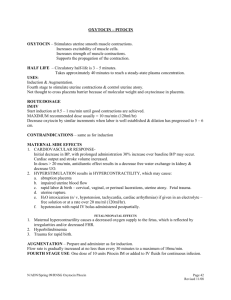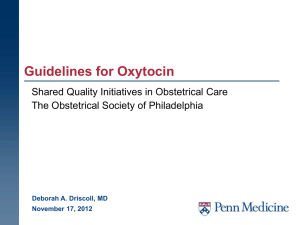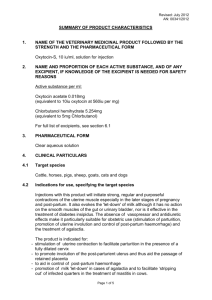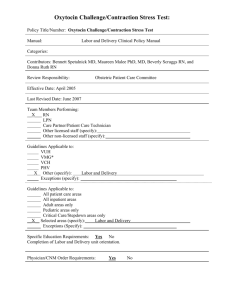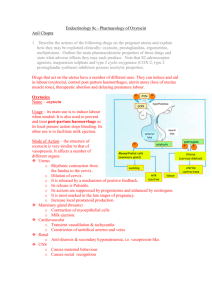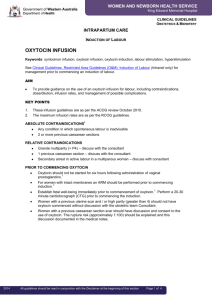Oxytocin For Post Partum Hemorrhage
advertisement
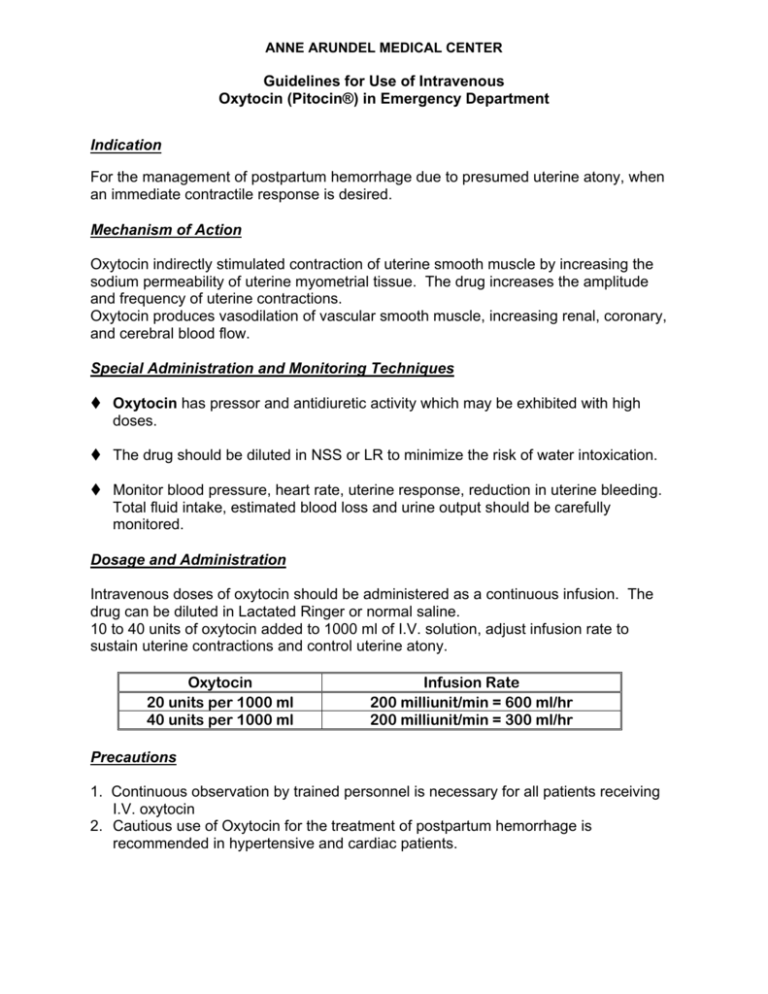
ANNE ARUNDEL MEDICAL CENTER Guidelines for Use of Intravenous Oxytocin (Pitocin®) in Emergency Department Indication For the management of postpartum hemorrhage due to presumed uterine atony, when an immediate contractile response is desired. Mechanism of Action Oxytocin indirectly stimulated contraction of uterine smooth muscle by increasing the sodium permeability of uterine myometrial tissue. The drug increases the amplitude and frequency of uterine contractions. Oxytocin produces vasodilation of vascular smooth muscle, increasing renal, coronary, and cerebral blood flow. Special Administration and Monitoring Techniques Oxytocin has pressor and antidiuretic activity which may be exhibited with high doses. The drug should be diluted in NSS or LR to minimize the risk of water intoxication. Monitor blood pressure, heart rate, uterine response, reduction in uterine bleeding. Total fluid intake, estimated blood loss and urine output should be carefully monitored. Dosage and Administration Intravenous doses of oxytocin should be administered as a continuous infusion. The drug can be diluted in Lactated Ringer or normal saline. 10 to 40 units of oxytocin added to 1000 ml of I.V. solution, adjust infusion rate to sustain uterine contractions and control uterine atony. Oxytocin 20 units per 1000 ml 40 units per 1000 ml Infusion Rate 200 milliunit/min = 600 ml/hr 200 milliunit/min = 300 ml/hr Precautions 1. Continuous observation by trained personnel is necessary for all patients receiving I.V. oxytocin 2. Cautious use of Oxytocin for the treatment of postpartum hemorrhage is recommended in hypertensive and cardiac patients. Adverse Effects Gastrointestinal – nausea, vomiting Cardiovascular – arrhythmias and premature ventricular contractions have been reported. The cardiovascular effects of oxytocin used postpartum consist of Hypotension followed by a period of Hypertension. Endocrine metabolic – water intoxication, dilutional hyponatremia Neurologic – headache, seizure, subarachnoid hemorrhage Hematologic – afibrinogenemia (fatal) Miscellaneous – anaphylaxis Comments Pharmacologic Agents Used in Postpartum Hemorrhage Medication Oxytocin Dose Route of Administration and Frequency 10–40 units in 500–1000 mL I.V. parenteral fluids. Continuous infusion given at ~200 milliunits/min Comment Avoid undiluted rapid IV infusion, which causes hypotension. Methylergonovine 0.2 mg (Methergine) I.M. or intramyometrial Every 2–4 hr Avoid if patient is hypertensive Carboprost tromethamine (Hemabate) 0.25 mg (250 microgram) I.M. or intramyometrial Every 15–90 min (not to exceed 8 doses) Avoid in asthmatic patients; relative contraindication if hepatic, renal, and cardiac disease. Diarrhea, fever, tachycardia can occur. Misoprostol (Cytotec) 800-1000 microgram Rectal Single dose Reference: ACOG Practice Bulletin: Clinical Management Guideline for Obstetrician-Gynecologists. #76 Oct 2006: Postpartum Hemorrhage Obstetric drug therapy. In: Koda-Kimble MA, et al., eds. Applied therapeutics: the clinical use of drugs. 8th ed. Philadelphia: Lippincott Williams & Wilkins; 2005. Postpartum Hemorrhage Kit “Postpartum Hemorrhage” kit will be created in the Emergency Department Pyxis. When drugs are needed, nursing can withdraw meds under “kit”, and then pick “Postpartum Hemorrhage kit”. Each pocket will open sequentially, allowing nurse to access the drugs. 4 1 2 5 Oxytocin: 10 units per ml vial Methylergonovine: 0.2 mg per ml ampule (Refrigerated) Carboprost: 250 microgram per ml ampule (Refrigerated) Misoprostol: 200 microgram per tablet Pharmacy Department/Clinical Services IV Additive Service ________________________________________________________________ DRUG NAME STORAGE REQUIREMENTS PREPARATION RESULTING CONCENTRATION STABILITY Oxytocin 40 units per 1000ml Room temperature Add 40 units (4 ml) of Oxytocin to 1000 ml of LR or NSS 40 milliunits/ml (0.04 units/ml) 24 hrs Room temperature Add 20 units (2 ml) of Oxytocin to 1000 ml of LR or NSS Oxytocin 20 units per 1000ml Premix 20 units in 1000 ml LR 24 hrs 20 milliunits/ml (0.02 units/ml)

